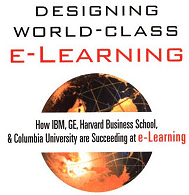Designing World-Class e-Learning
By Murray Bourne, 26 Jun 2005
by Roger C. Schank
A Summary Review

Schank is strongly opinionated - but we need a jolt occasionally to produce fresh approaches to education. There are several themes throughout this book (eg, learning is best done when we do something, failure should be encouraged, institutions should be about learning and not only about certification) that are particularly useful.
While I don't agree with all his arguments, there is a lot to like in what he says.
The intended audience for this book is training departments within large companies, but much of what he says applies to educational institutions.
The book contains screen shots throughout of e-learning designs that work (his own, of course) and those that don't (everyone else's).
Goal of Effective e-Learning
"The goal of effective e-learning must be to re-create as well as possible the breadth of experience an employee needs in an intense, danger-free, inexpensive and timely fashion. E-learning should look and feel exactly like the job the learner is being trained to assume." (p. 12)
Learning by Doing.
Having the real experience, or at least as close as possible using simulations, is the key to successful job training.
"We all know we learn by doing. John Dewey ... complained [in 1916] that schools insist on telling students what they need to know despite research clearly demonstrating that we have difficulty retaining and can rarely use information that we are told." (p. 13)
Stories
We need to incorporate true stories from the experiences of workers actually doing the job - stories where there were difficult problems to solve.
Case Studies
The writer goes on to describe implementations of successful "e-learning by doing" in IBM, A. G. Edwards, Enron (before its collapse) and Wal-Mart.
Failure
Why are we so concerned with failure rates? Schank rightly says that learning comes from making mistakes in a controlled environment and realising the consequences of them. Some of his e-learning simulation designs set the student up to make various decisions - some will be catastrophic and others will be acceptable. But the important thing is the learner can call up tutoring on the various options available and make more informed decisions.
"In reality, people who never fail are bored out of their skulls and lack risk-taking ability and creativity." (p. 65)
He says it is important to provide situations where students experience "safe failure" (p 67). Think about flight simulators. Trainee pilots are repeatedly put in situations where they must make vital and quick decisions to save the plane. if they "crash", they learn a valuable and emotional lesson.
Teachable Moments
Mostly we tell students things in a lecture before they even know what the questions are. "Teachable moments" (p. 68) arise when the students are in situations where they are confused and are burning with questions. Our approaches, whether in e-mode or face-to-face, must put students in positions which lead to teachable moments.
Programming
Coming from a computer science background, it is interesting to see what Schank says about the teaching of programming at Columbia University (pp 196 ff).
"... the student is immersed in real-world situations in which he faces the same challenges as professional programmers. Playing the role of an entry-level programmer at a software company, the student learns how to write modern, Web-deliverable applets and applications with graphical user interfaces."
Assessing e-Learning using FREEDOM
The book provides several insights into approaches to assessing e-learning courses, based on the following (pp 215 ff):
- Failure - does the course enable failures that surprise the student?
- Reasoning - does it require students to figure things out for themselves?
- Emotionality - are the students having an emotional response?
- Exploration - are the students motivated to go and find out more by themselves?
- Doing - is the course built around learning by doing?
- Observation - are the observations that the students make memorable?
- Motivation - are the students caring about what they are learning or are they just worried about the grade?
Schank goes on to evaluate some example courses, including giving himself low marks for his own keynote lectures (which he probably gets paid very well for).
This is a book worth reading for anyone with a passion for student learning and who wants to know how to encourage it through meaningful simulations in e-learning.
Here is a link with some other interesting, provocative ideas inspired by R. C. Schank.
Be the first to comment below.
